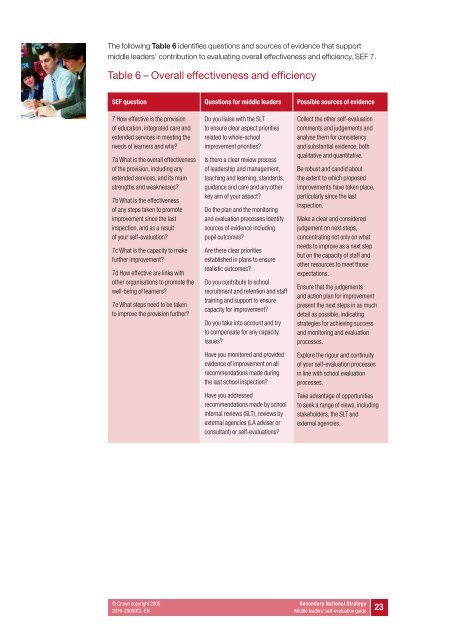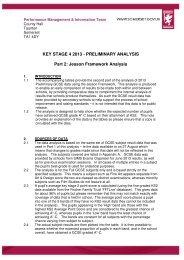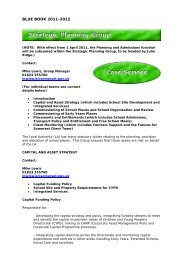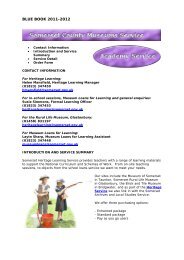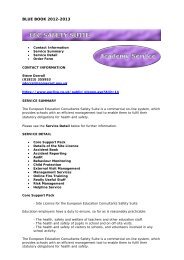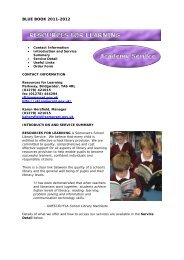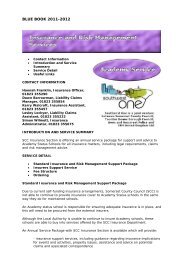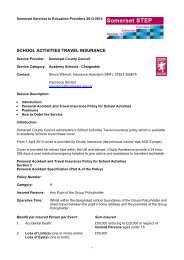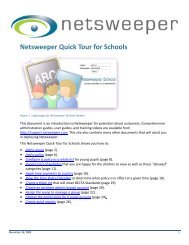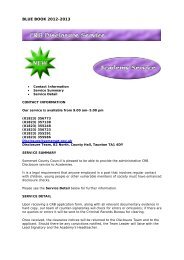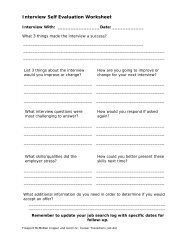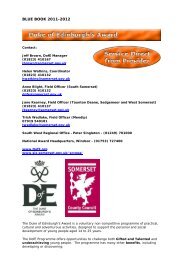Middle leaders' self-evaluation guide
Middle leaders' self-evaluation guide
Middle leaders' self-evaluation guide
Create successful ePaper yourself
Turn your PDF publications into a flip-book with our unique Google optimized e-Paper software.
The following Table 6 identifies questions and sources of evidence that support<br />
middle leaders’ contribution to evaluating overall effectiveness and efficiency, SEF 7.<br />
Table 6 – Overall effectiveness and efficiency<br />
SEF question Questions for middle leaders Possible sources of evidence<br />
7 How effective is the provision<br />
of education, integrated care and<br />
extended services in meeting the<br />
needs of learners and why?<br />
7a What is the overall effectiveness<br />
of the provision, including any<br />
extended services, and its main<br />
strengths and weaknesses?<br />
7b What is the effectiveness<br />
of any steps taken to promote<br />
improvement since the last<br />
inspection, and as a result<br />
of your <strong>self</strong>-<strong>evaluation</strong>?<br />
7c What is the capacity to make<br />
further improvement?<br />
7d How effective are links with<br />
other organisations to promote the<br />
well-being of learners?<br />
7e What steps need to be taken<br />
to improve the provision further?<br />
Do you liaise with the SLT<br />
to ensure clear aspect priorities<br />
related to whole-school<br />
improvement priorities?<br />
Is there a clear review process<br />
of leadership and management,<br />
teaching and learning, standards,<br />
guidance and care and any other<br />
key aim of your aspect?<br />
Do the plan and the monitoring<br />
and <strong>evaluation</strong> processes identify<br />
sources of evidence including<br />
pupil outcomes?<br />
Are there clear priorities<br />
established in plans to ensure<br />
realistic outcomes?<br />
Do you contribute to school<br />
recruitment and retention and staff<br />
training and support to ensure<br />
capacity for improvement?<br />
Do you take into account and try<br />
to compensate for any capacity<br />
issues?<br />
Have you monitored and provided<br />
evidence of improvement on all<br />
recommendations made during<br />
the last school inspection?<br />
Have you addressed<br />
recommendations made by school<br />
internal reviews (SLT), reviews by<br />
external agencies (LA adviser or<br />
consultant) or <strong>self</strong>-<strong>evaluation</strong>s?<br />
Collect the other <strong>self</strong>-<strong>evaluation</strong><br />
comments and judgements and<br />
analyse them for consistency<br />
and substantial evidence, both<br />
qualitative and quantitative.<br />
Be robust and candid about<br />
the extent to which proposed<br />
improvements have taken place,<br />
particularly since the last<br />
inspection.<br />
Make a clear and considered<br />
judgement on next steps,<br />
concentrating not only on what<br />
needs to improve as a next step<br />
but on the capacity of staff and<br />
other resources to meet those<br />
expectations.<br />
Ensure that the judgements<br />
and action plan for improvement<br />
present the next steps in as much<br />
detail as possible, indicating<br />
strategies for achieving success<br />
and monitoring and <strong>evaluation</strong><br />
processes.<br />
Explore the rigour and continuity<br />
of your <strong>self</strong>-<strong>evaluation</strong> processes<br />
in line with school <strong>evaluation</strong><br />
processes.<br />
Take advantage of opportunities<br />
to seek a range of views, including<br />
stakeholders, the SLT and<br />
external agencies.<br />
© Crown copyright 2005 Secondary National Strategy<br />
2076-2005DCL-EN <strong>Middle</strong> leaders’ <strong>self</strong>-<strong>evaluation</strong> <strong>guide</strong> 23


